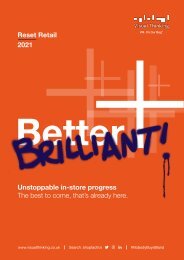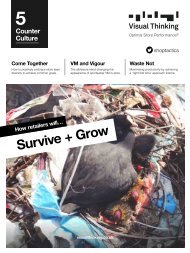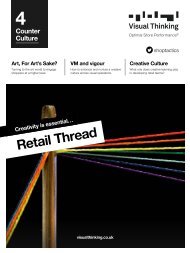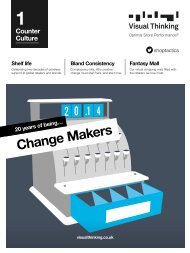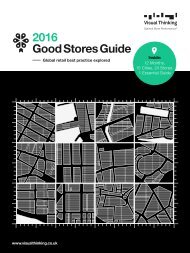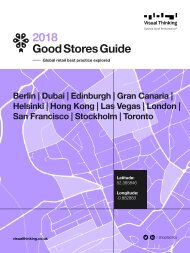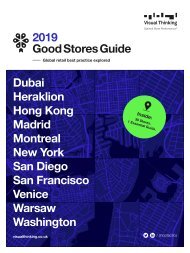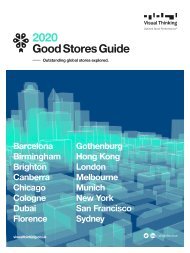Counter Culture 6
The Performance Issue: Learn how to turnaround store performance, not in years or months… but weeks.
The Performance Issue: Learn how to turnaround store performance, not in years or months… but weeks.
You also want an ePaper? Increase the reach of your titles
YUMPU automatically turns print PDFs into web optimized ePapers that Google loves.
<strong>Counter</strong><br />
<strong>Culture</strong><br />
Inspiring Retail Performance ®<br />
shoptactics<br />
Cutting Edge<br />
Change is happening and retailers<br />
must deliver it...right now.<br />
Balancing Act<br />
Only by getting the basics right<br />
can retailers truly achieve success.<br />
Squeeze More<br />
Why engaging store teams is vital<br />
if strategy is to result in action.<br />
The Performance Issue<br />
Razor Sharp<br />
visualthinking.co.uk<br />
Next
Special Features<br />
Contents<br />
4<br />
Focused Lens<br />
Redefining change means bringing a sense<br />
of purpose to your strategy, and taking<br />
decisive action.<br />
3<br />
Foreword<br />
7<br />
Balancing Act<br />
Only by getting the fundamentals right can<br />
retailers truly deliver commercial success.<br />
12<br />
Flag Waiving<br />
10<br />
Squeeze More<br />
Smart leaders know the power of their store<br />
teams. In challenging times, these are the<br />
people that will drive performance success.<br />
16<br />
17<br />
Comeback Kids<br />
New Waves<br />
23<br />
Frontline Battle<br />
As change becomes inevitable for many,<br />
how can embattled retailers steer a clear<br />
path to better times?<br />
18<br />
21<br />
Rebuild Fortunes<br />
Leading Ambitions<br />
Copywriters<br />
Marc Baker<br />
Kay Garrett<br />
25<br />
26<br />
Jet Set, Go!<br />
Fresh Thinking<br />
Contributors<br />
Karl McKeever karl@visualthinking.co.uk<br />
Kirsty Kean kirsty@visualthinking.co.uk<br />
Suzanne Tanner suzanne@visualthinking.co.uk<br />
Helen Bonser helen@visualthinking.co.uk<br />
Lisa Lawson lisa@visualthinking.co.uk<br />
Katy Trodd katy.trodd@visualthinking.co.uk<br />
Tina Emerson mail@visualthinking.co.uk<br />
Guest contributors<br />
Barbara Thau (New York)<br />
Mel Hales (London)<br />
3D Illustrations<br />
Paul Harris<br />
Designers<br />
Will Mulholland<br />
Ben Morgan<br />
Luis Tew<br />
<strong>Counter</strong> <strong>Culture</strong> is published by Visual Thinking Limited, Coach House 2, Lamport<br />
Manor, Old Road, Lamport, Northamptonshire NN6 9HF. Registered no. 03583878<br />
England. All rights reserved, reproduction in whole or in part without written<br />
permission is strictly prohibited. Editorial material and opinions expressed by thirdparty<br />
contributors do not necessarily reflect the views of Visual Thinking Limited.<br />
Contact Visual Thinking on +44 (0) 2080 506 028 or mail@visualthinking.co.uk<br />
27 Keeping Faith<br />
Get in touch<br />
Want to transform store<br />
performance? Send us an<br />
email (giving us brief details<br />
of your objectives and current<br />
challenges) to:<br />
mail@visualthinking.co.uk<br />
Call us: +44 (0) 2080 506 028<br />
Follow Us:<br />
visualthinking.co.uk<br />
Back<br />
Next
The Performance Issue 3<br />
Foreword<br />
This issue, we’re focused on Retail Performance.<br />
Unequivocally. Definitively. 100%.<br />
“Relax. Read.<br />
Then get<br />
to work.”<br />
Let’s face facts. Retail is undergoing something akin to a blood<br />
bath, and the need for retailers to grow sales, reduce costs and<br />
target their investment is more critical than ever before. In <strong>Counter</strong><br />
<strong>Culture</strong> 6, we explore what improving performance in physical retail<br />
stores really means – in its many forms – and identify ways retailers<br />
can take action to bring about change, and fast. And I hope this<br />
issue will inspire you to start your own journey to razor-sharp retail<br />
performance.<br />
In recent times, we’ve seen too many retailers fall by the wayside,<br />
while others are showing distinct signs of breakdown. Woeful<br />
trading performances and profits slumps at Debenhams and<br />
Marks & Spencer show that even the mighty can fall. Meanwhile,<br />
Mothercare and House of Fraser are in the throes of major<br />
restructuring under the terms of their respective CVAs.<br />
Negative headlines are screaming ‘how can we save our high<br />
street?’ Even the Daily Mail has taken up arms. Of more concern<br />
is that few people are offering retailers pragmatic and realistic<br />
solutions to turn big strategy into game-changing action. Which<br />
is precisely what’s needed. Changes must be identified and<br />
implemented, and now. Hesitate too long, and you may not be around<br />
to live another day. There are many parallels with the ubiquitous<br />
Brexit. Many retailers have spent months and months talking about<br />
the ‘plan’ with no substantial action. Smoke-and-mirrors do not drive<br />
sales. Customers don’t want jam tomorrow, but jam, honey and<br />
chocolate spread today.<br />
In short, retailers are in survival mode. Which is precisely why<br />
we’ve dedicated this entire issue to the power of performance.<br />
What does success look like? It’s about going back to the basics<br />
of good retail – a simple concept that has, frankly, been lost. We<br />
examine how better looking stores can become more productive<br />
and profitable. How more logical, easier-to-shop instore layouts will<br />
build footfall, get customers spending more with every visit and give<br />
you the competitive edge. How more engaging displays and instore<br />
promotions get shoppers’ hearts racing and their wallets open. And<br />
how you can make store teams more efficient and motivated to own<br />
the change most retailers simply have to deliver moving forward.<br />
What, where and how to invest for success – avoiding the traps.<br />
Read these pages. Be inspired. Then take action<br />
Back<br />
Karl McKeever<br />
Founder & Managing Director<br />
@karlmckeever | @shoptactics<br />
Next
The Performance Issue 4<br />
Lens<br />
Redefining change means<br />
bringing a sense of<br />
purpose to your strategy,<br />
and taking decisive action.<br />
Back<br />
Next
Inflation<br />
Forecasted Retail Price Index (RPI) inflation in the UK from<br />
1st quarter 2017 to 1st quarter 2023.<br />
The Performance Issue 5<br />
Change is typically considered<br />
a painful experience. Just ask<br />
any retailer going through major<br />
restructuring.<br />
Data: Statista 2018<br />
But by underpinning a programme of negative<br />
change with a sense of purpose, retailers can<br />
soften the blow, if not remove the pain barrier.<br />
Whether that’s redefining retail policy, embedding<br />
new capabilities or taking a fresh approach to<br />
instore measurement and KPIs, it’s about focused<br />
intent as opposed to the non-specific rhetoric of<br />
‘transformation’.<br />
Having travelled the world to experience retail<br />
excellence, we’re often asked “what do we<br />
mean by transformation?” But the question now<br />
would be “should we be using the word at all?”<br />
Transformation is seen as long-winded, expansive<br />
and costly. We all know what we want, but the<br />
challenge is to explain how you’re actually going<br />
to deliver it. Actions need to be incisive and<br />
immediate. Real change. Right now.<br />
Results focused.<br />
IMAGE: House of Fraser is one of several retailers to recently announce CVA proposals.<br />
© House of Fraser<br />
6,000<br />
5,500<br />
5,000<br />
4,500<br />
4,000<br />
UK High Street Closures<br />
5,855 outlets closed on UK high streets in 2017,<br />
at a rate of 16 stores a day.<br />
Closures<br />
Openings<br />
2013 2014 2015 2016 2017<br />
“If this sounds<br />
disheartening,<br />
do something<br />
about it.”<br />
Plenty of retailers<br />
currently find themselves<br />
in a chrysalis-like state:<br />
no longer what they<br />
were, but not what they<br />
will be, either. To avoid<br />
this becoming a state<br />
of purgatory, they must<br />
act. Few have the luxury<br />
of waiting years, or even months, for their grand<br />
transformation to manifest itself.<br />
So how do you make retail excellence a way<br />
of life in your stores? We are seeing a growing<br />
divide between those who are enjoying success<br />
and those struggling to survive. If this sounds<br />
disheartening, do something about it. Question<br />
everything about what you’re currently doing<br />
instore. Tackle the barriers that are preventing great<br />
performance, take aim and take action. Above all,<br />
view the world from your customers’ perspectives<br />
and engage colleagues to challenge the structures,<br />
habits or inertia that may be holding you back.<br />
Data: The Local Data Company for PwC<br />
Back<br />
Next
The Performance Issue 6<br />
You may be one of<br />
the lucky ones who<br />
are thriving, but it’s<br />
more likely that you’re<br />
another ambition-filled<br />
retailers<br />
but confused retailer:<br />
capable of greatness,<br />
but currently falling<br />
short. So take note –<br />
this strategy makes a lot of sense (and a lot more<br />
profit). Confronting the truth is never easy. But the<br />
message is clear: you can’t keep doing more of the<br />
same – it just isn’t working.<br />
“To do more<br />
than survive,<br />
must act.”<br />
So, next time someone internally utters the word<br />
‘transformation’, ask yourself who can help you<br />
really make better possible? Don’t be surprised<br />
if the answer comes from within, recognising the<br />
need to work with others to get it out<br />
For better performance visit<br />
visualthinking.co.uk<br />
IMAGE: New Look has already embarked on delivering positive change instore.<br />
Moving Forward<br />
When thinking about achieving<br />
a step change in store performance, there<br />
are three common questions to ask:<br />
importantly, add the ‘why’ and ‘how’. That means taking<br />
what are often a set of complex challenges and making the<br />
solution very simple to engage those at store level and add<br />
meaningfulness. The people at the cutting edge of store<br />
operations need a clear sense of what they are being asked<br />
to do, with a sense of ownership, and the skills needed to<br />
deliver change effectively – in every store, every day.<br />
Are your current retail and VM execution<br />
policies working for you?<br />
Forget lofty transformation strategy. Clear, relevant and<br />
effective VM policy is what your stores need most. VM policy<br />
is intended to clarify the ‘what’. But many do not reflect the<br />
needs of retailers or fail to resonate with both store teams<br />
and customers. It needs to be deeply anchored in your retail<br />
operations. Do you have one? Is it right for your brand, and<br />
your customers? Is it sufficiently defined? And, crucially, is it<br />
easy to implement instore – quickly and consistently? If you<br />
can’t answer these questions with confidence, this is the first<br />
place to start. You won’t get very far without it.<br />
How can you embed change?<br />
The truth is, people are naturally resistant to change - unless<br />
there’s a clear benefit to them. That’s an issue for retailers<br />
in today’s competitive landscape, where radical change<br />
is required, where the benefits take longer to emerge.<br />
Engaging store teams is vital to make your vision for change<br />
a reality. This should go beyond just defining the ‘what’ and,<br />
How can you deliver change today?<br />
The secret to achieving an immediate upturn in<br />
performance is about knowing where to start. Having<br />
expert support from those who can identify the issues,<br />
foresee the pitfalls, and come up with workable solutions<br />
quickly is key. Costly store refurbishment programmes<br />
or a rush to technology are not, and should not, be the<br />
answer. Leaders really do need to go back to basics. A<br />
focus on retail standards, visual merchandising policy and<br />
team engagement may not seem earth-shatteringly new.<br />
Indeed, many consider these ‘gentler’ qualities of store<br />
performance as not being vital to success. And that’s<br />
where they go wrong. But it doesn’t end there. The ‘what’<br />
needs to be supported by a plan of action that provides a<br />
roadmap to success, informs capability development, and<br />
can be measured to prove the results of any changes.<br />
So, instead of simply talking transformation, ask the<br />
questions that will quickly deliver change. The results will be<br />
amazing. Find answers quickly from sources you can trust<br />
to deliver<br />
Back<br />
Next
The Performance Issue 7<br />
Act<br />
Only by getting the<br />
fundamentals right can<br />
retailers truly deliver<br />
commercial success.<br />
Back<br />
Next
The Performance Issue 8<br />
Improved Retail Standards<br />
How our work signalled better compliance across all O2 stores.<br />
Lisa Lawson<br />
Before<br />
After<br />
Senior Retail Specialist<br />
@shoptactics_ll<br />
Back to basics. Not a term many<br />
retailers embrace. Why? Because it’s<br />
not something shareholders or internal<br />
teams can get excited by, which is why<br />
they often pay it little attention.<br />
But they should.<br />
69%<br />
96%<br />
While visual merchandising has typically been thought<br />
of in terms of soft, intangible benefits, it’s time to<br />
think again. Because here is where retail success is<br />
conceived, born and reborn.<br />
“...As Nike would say,<br />
‘Just Do It’ (and as we<br />
would add, do it now).”<br />
IMAGE: The NYC store of Mansur Gavriel. It’s not just the Italian made product that demonstrate<br />
great attention to material, colour and detail.<br />
We need to revise our language in terms of what<br />
drives commercial success. Let’s forget the term<br />
‘experiential’. Similarly ‘ornamental’ design features.<br />
These won’t get shoppers buying. ‘Back<br />
to basics’ may not be sexy, but it’s a vital<br />
concept. Put simply, if a customer enters a<br />
store and standards are poor, the range is<br />
uninspiring and they can’t find the item or the<br />
size they’re looking for, they’ll leave empty<br />
handed. Essentially, better stores equal<br />
better performance and increased sales.<br />
Period.<br />
Stores need to perform commercially, like never<br />
before. Talking about transformation is futile unless<br />
words are backed up by resolute and persistent<br />
action. Prevarication kills business. Focused and<br />
determined change resurrects it.<br />
This is the time for senior leaders to boldly look folly<br />
in the eye and stand firm. Yes, investing in technology<br />
is important and has its place. But it won’t be the<br />
saviour of retail in the here and now. And right now,<br />
that’s what many retailers should be concerned<br />
about. They have to start asking ‘what can we do<br />
today to make a visible difference?’ No more future<br />
gazing... as Nike would say, ‘Just do it’ (and as we<br />
would add, do it now, and routinely).<br />
Back<br />
Next
The Performance Issue 9<br />
IMAGE: Nordstrom Men’s Store, NYC.<br />
Those brands that have focused efforts on a more<br />
fundamental approach to solving the essentials of<br />
store ‘look’, experience and operational standards<br />
are, unsurprisingly, those who are seeing a gamechanging<br />
performance. If your stores are struggling<br />
to perform, it’s time to address their failings with the<br />
same clarity<br />
For more information visit<br />
visualthinking.co.uk<br />
See It<br />
Like It<br />
Try It<br />
Buy It<br />
It sounds obvious, but if you<br />
want to sell more instore,<br />
customers first have to be<br />
able to find your products.<br />
That new must-have item<br />
being promoted by social<br />
media influencers and in<br />
store windows – can you<br />
see it instore? Both overall<br />
store layout and individual<br />
categories also have to<br />
be logical to shop, and<br />
products must be easy to<br />
find. That means placing a<br />
key focus on replenishment<br />
too – you won’t sell anything<br />
if it’s languishing in<br />
the stockroom.<br />
Online retailing has<br />
functionality licked.<br />
Customers entering<br />
your store are seeking<br />
inspiration. So give it to<br />
them. An understanding of<br />
the fundamental basics of<br />
product presentation should<br />
extend beyond product<br />
availability and maintaining<br />
retail standards; it should<br />
inform purchase behaviour,<br />
tell compelling product stories<br />
and push average transaction<br />
values skyward. Applied<br />
well, the distinct elements of<br />
effective visual merchandising<br />
can serve as the blueprint for<br />
ongoing sales success.<br />
Delight the senses and make<br />
memories. Enjoy a great<br />
instore experience and you’ll<br />
want to do it again and again.<br />
That’s where giving shoppers<br />
an opportunity to do, taste,<br />
feel, hear your brand and<br />
product message can go far<br />
beyond simply presenting<br />
‘what good looks like’ instore.<br />
It’s where actual stores<br />
beat online shopping hands<br />
down. A positive experience<br />
turns browsers into buyers,<br />
stimulating shopper interest<br />
into transactions.<br />
With a clearly defined and<br />
simple-to-implement VM<br />
policy in hand, store teams<br />
will be able to dedicate<br />
themselves to bringing the<br />
retail experience to life in<br />
a way that’s enjoyable and<br />
easy to shop. But sales<br />
success can’t be built on<br />
the efforts of one person<br />
alone. So make sure every<br />
member of your store teams<br />
knows what good looks like.<br />
Get it right and sales will<br />
increase. Fact.<br />
IMAGE: The new John Lewis ‘experiential’ concept in Westfield, London.<br />
Back<br />
Next
The Performance Issue 10<br />
More<br />
Smart leaders know the power of their<br />
store teams. In challenging times,<br />
these are the people that will drive<br />
performance success.<br />
Back<br />
Next
The Performance Issue 11<br />
Alarming statistics from the<br />
high street are hard to avoid. So<br />
far, over 20,000 jobs have been<br />
cut in the retail sector in just the<br />
first six months of 2018.<br />
Fewer Jobs<br />
Kirsty Kean<br />
Lead Retail Specialist<br />
@shoptactics_kk<br />
Employment in the UK retail sector has been<br />
declining for more than two years.<br />
Total employed three-month average (YoY change)<br />
2012 2013 2014 2015 2016 2017 2018<br />
Data: British Retail Consortium<br />
10%<br />
-10%<br />
With high-profile names crumbling and others<br />
conducting savage restructuring, it’s clear that<br />
change is afoot. But how do retailers survive, let<br />
alone thrive?<br />
Strategic decisions are made from the top<br />
down, cascaded to those who have to<br />
implement changes – the store teams. That’s<br />
why, when it comes to your new vision, it’s vital<br />
that store teams ‘get it’. Strong leadership is<br />
a must. But equally, so is cohesive, seamless<br />
teamwork, with everyone pulling effortlessly<br />
together to deliver the common goal. Success<br />
cannot be built by one person alone. Retailers<br />
perform best when their people work together,<br />
each with a clear understanding of how their<br />
role contributes to overall performance, and<br />
how they personally can make change happen.<br />
0<br />
Conversely, when outcomes are not plainly<br />
defined, the results can be toxic. Ambiguity of<br />
change can negatively impact the experience<br />
for shoppers, store teams and, ultimately,<br />
retail performance.<br />
For the past 20 years, I have<br />
worked with retailers around<br />
the world to leverage the<br />
power of their people instore.<br />
Many elements of my job<br />
involve improving the ‘visual’<br />
retail experience, but that’s<br />
only half the story. In our<br />
current straitened times, many<br />
retailers are forced to make<br />
tough decisions. Reducing numbers is an<br />
understandable (and often necessary) first<br />
step for those seeking to improve fortunes.<br />
But when you need the energy, commitment<br />
and hands-on capability to deliver, build and<br />
win, there is no substitute for engaged and<br />
motivated store teams. Retailers driven to<br />
workforce reduction must see their remaining<br />
store teams as a performance powerhouse,<br />
the driving force uncompromisingly marching<br />
to success. Here, they need to squeeze every<br />
last drop out of what is arguably their most<br />
important asset – their people.<br />
Energised and focused store teams digging<br />
deep behind shared visions and goals deliver<br />
results that are hard to beat. If more retailers<br />
can educate their teams in the importance<br />
of getting it right... they might really have<br />
something<br />
Do the math<br />
“There is no<br />
substitute for<br />
engaged and<br />
motivated<br />
store teams.”<br />
From stores transformed to staff engaged and time (often just<br />
weeks) taken to deliver visible change, the work of Visual Thinking<br />
in numbers. No wonder so many retailers turn to us. It figures…<br />
2,904 8,000 15%<br />
Big W – Number of<br />
regional managers,<br />
store managers and<br />
retail teams trained<br />
in just eight weeks.<br />
O2 – Total number<br />
of store employees<br />
to successfully<br />
complete our<br />
visual excellence<br />
programme.<br />
Wilko – Average<br />
sales uplift as a<br />
result of House<br />
Proud retail team<br />
engagement<br />
programme.<br />
Back<br />
Next
The Performance Issue 12<br />
Flag<br />
Waiving<br />
In a world where measurable<br />
performance matters, has the<br />
traditional flagship store had its day?<br />
Back<br />
Next
The Performance Issue 13<br />
Helen Bonser<br />
Senior Retail Specialist<br />
@shoptactics_hb<br />
In its heyday it was a spectacular<br />
status symbol for retailer optimism. But<br />
the once-mighty flagship store is now<br />
unquestionably, well, flagging.<br />
Take Dyson. Opening several flagship Dyson Demo<br />
stores worldwide in the US, Canada, UK etc, with<br />
the latest one now in Bangkok, feels like little more<br />
than grandstanding. With high rents and seemingly<br />
minimal customer footfall, the stores are almost<br />
museum-like: empty homages to the brand and its<br />
engineering excellence. And it begs the question...<br />
what is the point?<br />
Perhaps they are trying to demonstrate their prowess<br />
to customers in markets where they are lesser known.<br />
But the counter argument is: are high-profile malls<br />
and 5th Avenue really the best places for this? Or<br />
is it simply an egodriven<br />
exercise? Whilst<br />
I generally like the<br />
stores and their bold<br />
execution, I can’t help<br />
wondering about their<br />
longevity.<br />
“Perhaps it’s time<br />
to re-evaluate<br />
their role, content<br />
and format - or even<br />
their existence.”<br />
Flagship stores have<br />
long been accused of<br />
being vanity projects,<br />
designed to woo<br />
would-be investors. But all too often it’s clear these<br />
projects are white elephants – hugely expensive<br />
marketing showpieces that may add some value to<br />
brand equity, but add very little to the bottom line. Put<br />
simply, many flagship stores are vast money pits.<br />
For me, focus must surely be diverted from flagwaving<br />
to tangible action and visible transformation,<br />
at real scale, delivering visible change that makes<br />
IMAGE: The Hunter store in Toronto continues the brand’s investment in new stores and VM.<br />
a commercial difference. Delivering measurable<br />
success is possible, by moving away from<br />
showboating and back to good old-fashioned<br />
retailing. Investing in Stores of Learning is a good<br />
place to start, enabling retailers to learn real lessons<br />
from proposed changes to instore policies and<br />
principles, and offering retail teams an opportunity<br />
to understand the ‘why’ and, crucially, the ‘how’ – to<br />
do the right thing every day across all your stores.<br />
By applying these learnings across the<br />
entire store estates – effectively and at<br />
pace – retailers can implement genuine<br />
change.<br />
Before flying the flagship store, they<br />
must ask themselves: would they rather<br />
be vacuous attention seekers or a quietly<br />
confident, commercially successful<br />
brand?<br />
Flagships have long been an essential<br />
part of a brand’s store format strategy. Originally they<br />
were there to make the ultimate statement about what<br />
and who a brand is and have a halo effect on the<br />
rest of the store estate. But perhaps it’s time to reevaluate<br />
their role, content and format – or even their<br />
existence. Surely store format needs to be designed<br />
around shopper need and the problems that must be<br />
solved in their customer journey? Starting from here<br />
will mean that a flagship store may not be the answer<br />
Back<br />
Next
The Performance Issue 14<br />
Dyson Flagship Store,<br />
Toronto<br />
UK brand Dyson has opened a number of its<br />
flagship Demo stores in high profile global<br />
cities over recent months. The longevity of such<br />
hugely expensive marketing showpieces is likely<br />
to increasingly be called into question, with<br />
more and more brands needing to focus on the<br />
commercial realities of delivering success in a<br />
tough retail climate.<br />
Back<br />
Next
Making the<br />
Cut<br />
Underperforming stores cost retailers their<br />
future. Visual Thinking help retailers to<br />
deliver best practice retail experiences to<br />
transform sales performance.<br />
Focused investment. Big results.<br />
Get in touch<br />
1993-2018<br />
Call us +44 (0) 2080 506 028<br />
New Business Enquiries<br />
kirsty@visualthinking.co.uk<br />
Years<br />
visualthinking.co.uk<br />
Back<br />
Next
The Performance Issue 16<br />
Comeback<br />
Kids<br />
It’s decision time for<br />
Mothercare as its future<br />
remains uncertain.<br />
Suzanne Tanner<br />
Senior Retail Specialist<br />
@shoptactics_st<br />
Once the mother of all<br />
children’s brands, the fortunes<br />
of Mothercare are now resting<br />
in the balance.<br />
Under its recently announced CVA<br />
proposal, the retailer plans to close<br />
59 unprofitable stores and seek rent<br />
reductions in others. Just how can this<br />
complex retail story find its conclusion?<br />
Let’s look at a parallel. Faced with challenges<br />
of its own, US retailer Crate&Barrel chose<br />
an innovative response to changes in the<br />
shopping behaviour of expectant parents,<br />
closing all stores in its sister division,<br />
The Land of Nod, and opening dedicated<br />
Crate&kids departments within their<br />
own stores.<br />
This strategic decision makes Crate&Barrel<br />
perfectly placed to now target the entire<br />
family of shoppers. A clever move indeed.<br />
Returning to this side of the pond: what, if<br />
anything, could Mothercare learn from this?<br />
It’s decision time.<br />
PHOTOGRAPH BY: Sharon McCutcheon/Unsplash<br />
It’s clear that what the retailer needs is<br />
a prompt and powerful programme of<br />
transformational activities. While it has<br />
already taken a tough stance, what can it<br />
do to reverse its fortunes, rather than simply<br />
hold its current ground? Does it need its<br />
own stores, or could its future be in logical<br />
strategic alliances, moving towards a ‘shopin-shop’<br />
approach?<br />
For me, Mothercare stores are part and<br />
parcel of the brand, and it is far from<br />
being a lost cause. But it does need to<br />
find itself again, and with a more strategic,<br />
cohesive and radical approach. It’s a brand<br />
that’s crying out for attention and – with<br />
focus, expertise and discipline – it could<br />
potentially find itself back in its trusted role<br />
as the parent whisperer. Our American<br />
counterparts are stepping up to the mark.<br />
It’s now time for Mothercare to do the same<br />
Physical Retail<br />
vs Online Sales<br />
Store Online<br />
41% 59%<br />
28% 72%<br />
Back<br />
Next
The Performance Issue 17<br />
New<br />
Waves<br />
With big new developments<br />
popping up, can Faro<br />
rediscover its former glories?<br />
PHOTOGRAPH BY: Rodrigo Kugnharski/Unsplash<br />
Transformation in retail is one<br />
thing. But how about regeneration of<br />
an entire town’s retail fortunes? That’s<br />
the challenge facing Faro right now.<br />
The capital of Portugal’s Algarve once boasted a<br />
charming old town and harbour. But lately, tourists<br />
are more likely to spot boarded-up buildings, small<br />
and shabby bars and restaurants, and prolific<br />
graffiti. The property boom of the 2000s brought in<br />
a massive tourism influx, ably aided by the then-new<br />
low-cost airlines opening up the region as the go-to<br />
destination. Then came the global economic crisis<br />
that bred severe local debt, and subsequent austerity.<br />
Fast forward ten years and the town is undergoing<br />
a mini metamorphosis. The most recent retail<br />
development has opened within the last 12 months.<br />
Designed, developed, and managed by IKEA Centres,<br />
it is a large out-of-town development that includes<br />
three separate destinations: a full-scale IKEA store,<br />
Mar Shopping Centre and the Algarve Designer Outlet.<br />
Faro – Explorer<br />
To read more visit visualthinking.co.uk<br />
The good: the IKEA is huge, and likely to serve the local<br />
community of new villas, apartments and developments<br />
well. Other notable shops in the development include<br />
a superb Primark. The bad: it’s somewhat disappointing<br />
that the biggest new development in the region is so<br />
corporate, and unlikely to do too much to restore the<br />
town’s former picturesque glory. And the ugly? Well,<br />
while the development brings money, the promise of jobs<br />
and an increase in growth and tourism, it is not going to<br />
prove a friend to other local commercial centres. One big<br />
development could mean the demise of other, smaller ones.<br />
Against such might, and money, and connections.... how<br />
can the charming old town survive? The challenge to<br />
Faro, as a town, is to recover prosperity and preserve its<br />
integrity. The challenge to mega brand players that can<br />
bring their new money and weighty influence to town is<br />
to act with responsibility to the whole society, and not<br />
simply to serve their own corporate interests. Retail is<br />
more than commercial: it’s societal. If one part of the<br />
community feels marginalised they’re unlikely to become<br />
fans. Watch this space...<br />
Back<br />
Next
The Performance Issue 18<br />
Rebuild<br />
Fortunes<br />
When retailers are teetering on the<br />
edge, it’s tempting to assume they’ll<br />
fall. But coming back from the brink<br />
is possible... if retailers seize the day<br />
and face up to the challenges ahead.<br />
Barbara Thau<br />
Guest Contributor<br />
Back<br />
Next
The Performance Issue 19<br />
Comebacks are hard to come by in<br />
retail. Few retailers lose their way and<br />
find their way back.<br />
The list of casualties is long and varied. Worldwide,<br />
the last two years alone marked the end of Sears<br />
Canada, the UK’s BHS, Australia’s Topshop and<br />
New Zealand’s Kiwi Clothing, along with US clothing<br />
chains American Apparel and THE LIMITED.<br />
But there are exceptions to the no-way-back-fromthe-brink<br />
rule. Retailers such as Best Buy, Starbucks<br />
and even the seemingly invincible Apple have all<br />
pulled off bona fide reversals of fortunes.<br />
Their triumphant revival strategies share some<br />
common ground, including a laser focus on core<br />
competency and a ruthless whittling away at<br />
whatever doesn’t serve.<br />
When J.C. Penney plucked former Apple merchant<br />
Ron Johnson to be CEO, Johnson wooed high-end<br />
shoppers by eliminating sale events and adding fancy<br />
merchandise from the likes of Sir Terence Conran.<br />
The result: billions lost in sales. The retailer ousted<br />
Johnson, then came back from the brink by outright<br />
apologising to its core base of Middle American<br />
IMAGE: US clothing retailer American Apparel is one of many to have closed its stores © JPDA.<br />
shoppers for abandoning them, bringing back bargains<br />
and coupons, and restocking the beloved store brands<br />
axed in the upscale makeover.<br />
Overall, retailers that have managed a turnaround have<br />
done so by serving unmet needs (Best Buy); uncorking<br />
new revenue streams by building on existing brand equity<br />
(Starbucks); pivoting to a shifting consumer base; and<br />
evolving with changing shopper tastes and habits.<br />
Righting a retail ship also calls for the unglamorous-butcritical<br />
work of getting one’s operational house in order.<br />
Merchandise is the lifeblood of every retail organisation.<br />
And if you can’t get the right inventory to the right<br />
shopper at the right time because your supply chain is a<br />
mess, nothing else much matters.<br />
Best Buy’s revival not only affirms some integral elements<br />
to successfully delivering real change, but also speaks<br />
to reinvention in the age of Amazon. The consumer<br />
electronics chain responded to changing shopping<br />
triggers, found a way to answer an unmet consumer<br />
need, and gave shoppers something online retail<br />
could not.<br />
IMAGE: Topshop began closing underperforming stores in Australia last year.<br />
Back<br />
Next
The Performance Issue 20<br />
It was a very different story back in 2012. The<br />
retailer was battling obsolescence as Amazon<br />
undercut its prices, and seemed helpless amid<br />
showrooming, when shoppers browse a store for an<br />
item, only to later buy the product online for less.<br />
New CEO Hubert Jolly brought in big changes.<br />
Best Buy has added services and experiences<br />
online can’t provide, such as hiring hundreds<br />
of salespeople to make profitable home visits<br />
and offering free, personalised electronics<br />
recommendations.<br />
IMAGE: The revamp of its apparel collections by J.C. Penney in favour of hip brands,<br />
like Joe Fresh, proved disastrous.<br />
The chain also reinvested a portion of these profits<br />
in technology to boost its supply chain speed and<br />
efficiency, with the goal of offering US shoppers<br />
next-day delivery. The results have paid off: Best<br />
Buy has boosted sales and earnings while gaining<br />
market share.<br />
Then there are the revivals shepherded by<br />
iconoclastic CEOs like Apple’s Steve Jobs and<br />
Starbucks’ Howard Schultz, who are etched into<br />
the DNA of the company. Their turnarounds have<br />
sprung largely from an intangible, yet intuitive, feel<br />
for their businesses.<br />
Schultz left Starbucks in 2000, returning in 2008<br />
when the coffee chain was struggling, beset by over<br />
expansion in the US. He reinvested in service via<br />
the human touch with baristas, moving away from<br />
cookie-cutter locations, giving each coffee house a<br />
flavour that reflected the region it served.<br />
As buying tangible things has become<br />
unprecedentedly cheap, easy, and unlimited<br />
with the endless aisle that is online shopping,<br />
consumers are looking for retail venues that do<br />
more than just sell things to get them out the door.<br />
Retail is both an art and a science. It seems retail<br />
reinventions must be that, too<br />
IMAGE: Returning Starbucks executive chairman Howard Schultz spearheaded a marked turnaround<br />
in fortunes.<br />
Barbara Thau is a New York-based business journalist<br />
and contributing retail reporter for Forbes.com, also<br />
covering consumer news and lifestyle trends for<br />
publications including CNBC, The New York Daily<br />
News and Fortune.com.<br />
Back<br />
Next
Leading<br />
The Performance Issue 21<br />
Ambitions<br />
How strong leadership<br />
can pave the way to a<br />
better future.<br />
PHOTOGRAPH BY: Samuel Zellar/Unsplash<br />
Great leadership is crucial in all<br />
walks of life. But while leading through<br />
continued success takes one type<br />
of person, pulling people up, making<br />
them believe and giving them hope and<br />
motivation during bleak times takes<br />
another altogether.<br />
Tina Emerson<br />
Learning & Development<br />
Manager<br />
@shoptactics<br />
If teamwork in retail is important, the right<br />
leadership is critical. A good example is former<br />
Burberry boss Christopher Bailey. He deserves to be<br />
applauded for his revolutionary work with the brand.<br />
A visionary leader, he turned Burberry’s fortunes<br />
around, making it Britain’s biggest luxury brand.<br />
But being the prominent figurehead of a brand is<br />
not without its challenges. All eyes are now firmly<br />
fixed on House of Fraser CEO Alex Williamson as<br />
he leads the beleaguered retailer through its CVA,<br />
and Debenhams chief Sergio Bucher as he pushes<br />
forward a series of uncomfortable measures to<br />
restore growth after a sharp drop in profits. And<br />
challenges are coming thick and fast for other<br />
senior retail leaders, who need to draw on all their<br />
resources to deliver decisive and effective change.<br />
Transforming a retail giant’s fortunes takes steely<br />
resolve, unswerving determination and complete,<br />
unshakeable faith in your decisions.<br />
For strong leaders, there is no room for sitting on<br />
the fence, watching and waiting or muddled visions.<br />
It requires a bold strategy, clear plan and meaningful<br />
action. And always a little luck.<br />
As 2018 continues to bring mixed fortunes for many<br />
retailers, fresh attention is firmly on those at the<br />
helm. True success can only be driven from the<br />
top, ably supported by solid teamwork. The broad<br />
shoulders of a business leader are designed to carry<br />
a business, and a brand, as they strive relentlessly,<br />
infinitely, for better.<br />
The time for mere fighting talk is over. The time for<br />
dynamic, inspiring leadership that packs a punch<br />
from all angles is here. And without helpful external<br />
factors, companies must do whatever they can<br />
themselves to create their own success by making<br />
changes in circumstances that will lead to business<br />
survival and growth.<br />
This is no time for the faint-hearted. And there is no<br />
time to waste<br />
Back<br />
Next
The Performance Issue 22<br />
1993-2018<br />
Now<br />
Years<br />
(and then)<br />
The choice of leading retailers and brands<br />
for the last 25 years, a lot has changed<br />
since Visual Thinking first began its<br />
journey. Back in 1993, the Ford Mondeo<br />
was king of the road, Pepsi Max had<br />
arrived, and Jurassic Park (the original)<br />
was the big box office smash. Many great<br />
retailers were also born, but many too<br />
have disappeared from our high streets<br />
for good. So, slip off those rose-tinted<br />
glasses for a timely reminder of what<br />
success and failure look like.<br />
Inspiring<br />
Retail<br />
Performance ®<br />
For more information visit<br />
visualthinking.co.uk<br />
Back<br />
Next
The Performance Issue 23<br />
Battle<br />
As change becomes inevitable<br />
for many, how can embattled<br />
retailers steer a clear path to<br />
better times?<br />
Back<br />
Next
The Performance Issue 24<br />
Mel Hales<br />
Guest Contributor<br />
With many retailers facing a serious<br />
battle to survive, building more resilient<br />
teams and individuals is increasingly key to<br />
staying on the offensive.<br />
While leading store teams through challenging periods of<br />
change is no easy feat, it is possible to navigate your way<br />
through and emerge into brighter days. We all have individual<br />
needs that must be met before we can work at our best. One<br />
of these is security. In our current climate, many are asking:<br />
“Will our store be next, and will I lose my job?” Where we<br />
remove stability in one place, we must replace it in another.<br />
As a leader you must be the constant in the face of change.<br />
Facebook’s famous internal slogan: ‘Move fast and break<br />
things’, is contrary to how we’re often taught to act. But<br />
this formed the basis of their success. It also embodies<br />
their attitude to failure. Anecdotally, one contract engineer<br />
crashed the Facebook site for 30 minutes because he tried<br />
a new way of fixing a bug. Rather than berating him, they<br />
offered him a full-time contract.<br />
Similarly, your<br />
company’s attitude to<br />
“It’s about<br />
failure will dictate how<br />
willing your people<br />
normalising<br />
are to try new things.<br />
Getting them to think the concept<br />
differently could<br />
of change.”<br />
transform an average<br />
customer experience<br />
into a fantastic one.<br />
It’s about normalising the concept of change, because in<br />
precarious times, business as usual simply won’t work. But<br />
the natural reaction to the pressure of proving immediate<br />
results is to become even more risk averse. So they return to<br />
business as usual... and the future is predetermined.<br />
Change isn’t easy, but an empowering and emotionally<br />
intelligent approach to leadership will make it a lot easier.<br />
Resilience is not a fixed quality. It is something you can<br />
build, and helping your people to do so will pay dividends<br />
Mel Hales is the director of Rush Collective, a training<br />
consultancy specialising in wellbeing, leadership and<br />
team development.<br />
To learn more visit<br />
visualthinking.co.uk<br />
The retailers seeing positive<br />
change in store team performance<br />
right now all share four common<br />
themes (each a strong contributor<br />
to the notion of engagement,<br />
effectiveness, and productivity):<br />
Connecting<br />
Ensuring key people, regardless of their separate<br />
disciplines, recognise the importance of viewing the<br />
store experience through the eyes of the shopper (e.g.<br />
adopting a ‘Thinking Like A Customer’ and ‘Would I<br />
Buy It?’ mentality). Honesty counts.<br />
Communicating<br />
Improving people’s understanding of the ‘what’ and<br />
the ‘why’ (e.g. sharing the vision, setting expectations<br />
of standards, and rolling out policy). Don’t sugar coat<br />
hard truths. Keep it real. Develop a culture of everyday<br />
excellence, inspiring people to climb higher and to raise<br />
the bar. Celebrate, and share, the smallest success!<br />
Coaching<br />
Helping people to build the skills they need to perform<br />
tasks quickly, effectively and consistently, so that retail<br />
best practice becomes a way of life instore. Make it<br />
easy. Keep it clear. Get it to last.<br />
Cohesive<br />
The company plan unites people in a shared sense of<br />
purpose for working together effectively, recognising<br />
shared commitment to better results. Leaders inspire<br />
and make it possible for colleagues to be successful. A<br />
‘win/win’ culture is expressed and rewarded, benefitting<br />
everyone: shoppers, employees and shareholders.<br />
Back<br />
Next
Jet Set, Go!<br />
The Performance Issue 25<br />
Here’s our pick from the most recent in our<br />
Explorer travel series. Take a moment and discover<br />
global retail best practice. Go explore<br />
Venice<br />
Italy<br />
A long-time favourite destination for<br />
romantics, we paid a visit to see what<br />
the city has instore for lovers of retail.<br />
Hong Kong<br />
China<br />
As shoppers from the mainland start<br />
to return, visitors are rarely further<br />
than a short taxi ride from rich retail<br />
experiences.<br />
Split<br />
Croatia<br />
In many ways, Croatia is a nation<br />
at odds with itself. A young but<br />
conservative nation, its dual personality<br />
is perfectly encapsulated in the retail<br />
offering of its second city.<br />
Washington DC<br />
USA<br />
It might have more impact on the political<br />
rather than retail landscape, but there are<br />
several stores within the capital’s malls<br />
(and beyond) that get our vote.<br />
Let’s Explore<br />
visit visualthinking.co.uk<br />
Berlin<br />
Germany<br />
While there is plenty on offer for those<br />
seeking the big and the bold, those<br />
seeking to explore a new path will find<br />
a world of much smaller delights at their<br />
fingertips.<br />
Faro<br />
Portugal<br />
The global economic crisis bred severe<br />
local austerity. Fast forward ten years and<br />
Faro is undergoing a mini metamorphosis.<br />
But are might and money threatening to<br />
overshadow the old town’s charm?<br />
Toronto<br />
Canada<br />
With its unique blend of cultures,<br />
heritage and customs, Toronto makes<br />
for a real retail metropolis.<br />
Back<br />
Next
The Performance Issue 26<br />
Fresh<br />
Thinking<br />
A new approach to front<br />
of store promotions sees<br />
Waitrose leading the way<br />
in innovative thinking.<br />
Grocery retail is notoriously<br />
competitive, but especially in the<br />
current climate. These are times of<br />
‘generational change’.<br />
Suzanne Tanner<br />
Senior Retail Specialist<br />
@shoptactics_st<br />
Just being good isn’t good enough. So where does<br />
this leave powerhouse retailers like Waitrose? Owner<br />
John Lewis Partnership has reacted swiftly to a profits<br />
warning by vowing a period of significant investment<br />
to grow sales, with CEO Rob Collins declaring he will<br />
make Waitrose more ‘Waitrose’.<br />
This investment will focus on developing unique<br />
products and services and placing increased<br />
emphasis on the brand. According to Sir Charlie<br />
Mayfield, chairman of the John Lewis Partnership:<br />
“For us, the relentless pursuit of greater scale is not<br />
the right course. Our plans put differentiation, innovation<br />
and partner-led service at the heart of our offer.”<br />
Part of that change has seen it working closely with Visual<br />
Thinking over recent months, delivering a fresh approach<br />
to VM implementation in its front of store campaigns.<br />
Using the latest digital software, we used 3D modelling<br />
to bring merchandising planograms to life like never<br />
before. We combined this with a new approach to partner<br />
engagement and instore training to help people work<br />
more efficiently, and deliver outstanding presentation for<br />
shoppers. Fresh indeed<br />
It works<br />
This initiative has clearly delivered improved performance.<br />
Retail teams used detailed visual guides for all front<br />
of store fixturing, enabling them to understand and<br />
implement VM guidelines more efficiently and preserving<br />
the integrity of campaigns across all stores. The unique<br />
solution is a masterclass in visual excellence with clear<br />
commercial results. Smart.<br />
To view case study visit<br />
visualthinking.co.uk<br />
Back<br />
Next
The Performance Issue 27<br />
better. Beginning as one shop, it<br />
has learned and grown over the<br />
past decade, now boasting over 80<br />
boutiques in 23 states.<br />
PHOTOGRAPH BY: Karl McKeever<br />
Its strong USP is certainly unique:<br />
the store is church run, backed, and<br />
owned, with all profits going back<br />
to the church. No shareholders.<br />
No partners. Just a community.<br />
Enlightened.<br />
Can faith and<br />
good business go<br />
hand in hand? With<br />
many retailers facing<br />
considerable<br />
Faith<br />
challenges<br />
right now,<br />
it’s never<br />
been more<br />
important for<br />
leaders to<br />
Keeping<br />
keep the faith.<br />
In a bid to<br />
better resonate<br />
with today’s<br />
shoppers,<br />
countless<br />
retailers have<br />
launched<br />
ethical<br />
initiatives<br />
to foster a stronger sense of<br />
community and social purpose.<br />
“An important<br />
reminder of<br />
the values of<br />
the brand.”<br />
Putting its money where its mouth<br />
is, every month stores can find and<br />
choose a local non-profit charity<br />
to donate to. The brand taps into<br />
idealistic motivations and provides<br />
deeper reasons for its existence<br />
beyond making money. Prayer<br />
request books can be found in the<br />
changing rooms, a subtle touch<br />
but an important reminder of the<br />
values of the brand. But that does<br />
not mean making money is a<br />
secondary focus. Its Washington<br />
store demonstrates a clear retail<br />
know-how,<br />
competently<br />
executed and<br />
delivered. The<br />
experience<br />
is on par, if<br />
not ahead<br />
of its peers,<br />
demonstrating<br />
that a strong<br />
calling and declared ‘conviction’<br />
can also be very good for business.<br />
For US retailer Altar’d State,<br />
keeping the faith or taking an<br />
ethical stance is certainly not<br />
a problem. Mixing faith and<br />
fashion, it started with a mission<br />
to fill a gap in the retail industry<br />
and change the world for the<br />
An extreme example, maybe, but<br />
Altar’d State delivers a tangible<br />
connection between its brand and<br />
its customers. And right now, that’s<br />
something that many struggling<br />
retailers in the UK are praying they<br />
can deliver<br />
PHOTOGRAPHY BY: Grant Whitty<br />
Back<br />
Next
Cutting<br />
The Performance Issue 28<br />
Edge<br />
Putting performance at the heart of<br />
this issue of <strong>Counter</strong> <strong>Culture</strong> has made<br />
one thing abundantly clear: Judgement<br />
Day is here and only those<br />
“Get up.<br />
Get moving<br />
who embrace change and<br />
turbo charge better retail<br />
execution will survive.<br />
Year-on-Year Sales Increase (%)<br />
How focused investment has delivered measurable uplift in retail<br />
performance with support from Visual Thinking.<br />
Harley-Davidson<br />
Sheridan<br />
24<br />
and get in touch.”<br />
Focus is key. Blind pursuit of<br />
transformation is simply a waste of<br />
time and energy. Real transformation centres on this<br />
question: what can you do today to deliver change?<br />
Much has been said of the role of new technology as<br />
the ‘saviour’ for retailers. I simply say: beware ‘false<br />
gods’. The investment and infrastructure requirements<br />
are unrealistic for businesses already in trouble.<br />
0<br />
Rapid change<br />
The Original Factory Shop – proportion of store estate transformed in<br />
just eight weeks.<br />
Completed<br />
Total<br />
44<br />
37<br />
188<br />
But, harnessing your greatest asset – your people<br />
– is what can make the difference. Your plan for<br />
change needs to engage all levels of employees –<br />
head office, regional management and store teams<br />
– giving them clearly defined guidance and new skills<br />
to drive a higher level of performance that serves your<br />
customers and, ultimately, makes your stores more<br />
profitable. Fail to do this and they will not know what<br />
good looks like and how to deliver it effectively, let<br />
alone why they’re doing it. A sobering thought.<br />
What is a plan without people to deliver it? And what<br />
are people without purpose? Redundant.<br />
When you have a rock-solid plan of action to deliver<br />
real, measurable improvements instore, in the here<br />
and now, there is no limit to what you can achieve.<br />
Now is the time for real action. Keep it simple. Get up.<br />
Get moving. And get in touch<br />
Back<br />
Karl McKeever<br />
Founder & Managing Director<br />
@karlmckeever | @shoptactics<br />
Next
Calling for<br />
Change<br />
Get in touch<br />
Call us +44 (0) 2080 506 028<br />
New Business Enquiries<br />
kirsty@visualthinking.co.uk<br />
Cull or cure? No retailer can afford to ignore<br />
poor store performance. Visual Thinking delivers<br />
1993-2018<br />
immediate change in every store, every day. Not in<br />
years or months… but in weeks.<br />
Years<br />
visualthinking.co.uk<br />
Back<br />
Next
Hi –<br />
Performance<br />
Inspiring Retail Performance ©<br />
Say hello to better stores and boost retail<br />
sales… not in years or months, but weeks.<br />
For 25 years, Visual Thinking has been helping retailers<br />
to bring about change instore, and fast. Led by a team of<br />
experienced and highly talented retail specialists, we deliver<br />
real, effective and immediate breakthroughs in performance.<br />
From defining visual policy and transforming store standards,<br />
to improving team engagement and VM skills<br />
Get in touch...<br />
+44 (0) 2080 506 028<br />
The story continues online...<br />
visualthinking.co.uk<br />
Follow us:<br />
Subscribe to our Podcast<br />
@shoptactics<br />
/shoptactics<br />
www.theretailexchange.co.uk<br />
/shoptactics<br />
Designed and produced by<br />
Published by Visual Thinking. All rights reserved.<br />
No part of this publication may be reproduced or transmitted in any form or by any means,<br />
electronic or mechanical, including photography, recording or any informational storage and retrieval<br />
system without the prior permission of Visual Thinking Limited.<br />
www.dsgnlab.com<br />
Back




